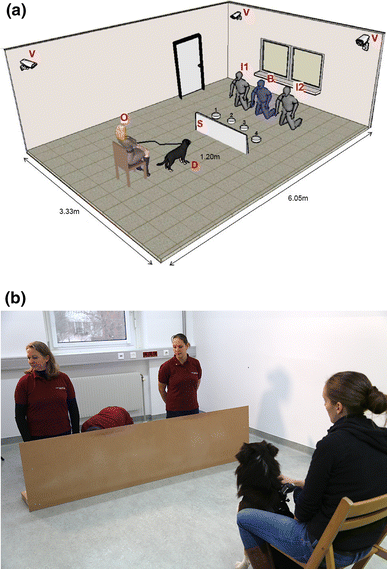
Turns out, dogs may be able to do what scientists thought no non-human animals could do: attribute mental states to humans.
When humans need to interpret the behavior of other humans, they assign mental states to the other and to themselves. This allows us to sort of “take on” the emotions, intentions, and needs of the other so that we can act and react accordingly.
This psychological and philosophical concept is called the Theory of Mind, sometimes referred to as mentalisation or mind-reading, and every person has a different level of it.
With regard to other non-human animals, it has always been highly contended whether or not any other species has this same ability. Alexandra Horowitz, PhD was one of the first to take an extensive look at theory of mind in dogs in her 2011 paper (PDF).
But cognitive biologists recently made further progress into this, and may have proved that dogs may indeed have strong levels of theory of mind.
In the new study published in Animal Cognition journal, researchers at the Messerli Research Institute of the University of Veterinary Medicine Vienna performed a new test.
This experiment procedure demonstrated that dogs can not only identify a human’s eye contact on a food source and find the hidden stash – they can also use this knowledge to further interpret human cues and find food which the humans can’t see themselves.

So what does this mean, exactly?
This ability to take on the perspective of another is a crucial component of social intelligence. Basically, it allows dogs to cope with an environment which is constructed and run by humans.
Until now, the Theory of Mind has only been assigned to humans. It develops somewhere in the 4th or 5th year of life, and describes our ability to grasp concepts like emotions, knowledge, desires, intentions, and beliefs.
This ability is typically denied in non-human animals.
Previously, when scientists looked at non-human animals for indications that they can grasp these mental states, only apes and corvids were confirmed as able to do so. Dogs had been tested for the ability, but the results were insufficient. Until now.
RELATED: Research Proves Dogs Know When You’re Lying
A New Approach
A new experimental approach was developed and tested out. These tests determined that dogs can follow the human gaze, and identify what the human was seeing and, thus, to understand what the human knew.
This “Guesser-Knower paradigm” is a standard test used when conducting research into attribution of knowledge to others.
This experiment involved two people: the “Knower,” who hid the food from the dog or at least knew where it was, and a “Guesser,” (in this case, the dog) who entered the room after the food got hidden or who had their eyes covered while it was hidden. The dog was unable to see the hiding of the food.
The next step was for the humans to inform the dog where the food was by pointing to different food containers. The Knower would point to the correct containers, and the Guesser would point to another.
Now you think, couldn't the dog simply smell the food? No. All the containers smelled like food. Dogs in the experiment couldn't user their noses to determine anything.
To get the food, the dog had to be able to understand which human knew the location of the food, and which human was only guessing, according to principal investigator Ludwig Huber. Therefore, the dog had to identify which human was reliable for information.
In about 70 percent of the cases, dogs correctly chose the container being identified by the gaze of the Knower. Results were independent of the positions of the food containers, the person acting as the Knower, and where the Guesser was looking.

Further Proof of Theory of Mind in Dogs
These tests were actually carried out in order to confirm a study previously conducted in New Zealand. The team developed a new test which provided clear evidence that dogs are able to take on the human perspective. This was called the “Guesser looking away” test.
This new test added a layer of complexity for the dogs by adding a third person, who sat in the middle and hid the food. On top of that, the person who hid the food did not give cues to its location.
The Guessers sat on either side of the Knower, looking in the same direction. So, one person was looking at the Knower, and the other person was looking away from them.
If the dog wanted to determine who the Knower was, it had to adopt the perspective of the informants, and follow their gazes.
Believe it or not, dogs performed just as well in this extremely difficult test. About 70 percent of the dogs mastered these trials.
RELATED: How Owners Lose Their Dogs’ Trust
The Implications
By following gazes and taking on the gazer’s knowledge, dogs could guess where invisible food was. By adopting the human perspective, dogs are able to determine what the human sees and what the human knows.
Therefore, they are able to determine which humans they can or cannot trust.
Dogs understand our behavior well. These studies determined that they can accurately comprehend our degree of attention.
According to Huber, this ability to adopt our perspective supports the notion that dogs possess the ability to interpret our behavior and anticipate our intentions. Therefore, they can modify their behavior enough to find their way in our very human world quite well.
Does the dog know?
 So if a dog can know where invisible food is located just by following a human gaze, what else can they understand? Can they understand when we intend to hurt them? Can they understand the difference between intentional harm and accidental harm?
So if a dog can know where invisible food is located just by following a human gaze, what else can they understand? Can they understand when we intend to hurt them? Can they understand the difference between intentional harm and accidental harm?
Most experienced dog owners would surmise that they indeed can. We’ve all tripped over our beloved pups, or dropped things near them (or even on them) by accident. Even if they are initially shocked, they are quick to forgive.
However, if someone intentionally kicks or hits a dog, it is generally observed that the dog seems to remember that long after it occurs.
While these studies don’t go as far as proving that dogs can comprehend the intentions of humans, they get us one step closer to that. The studies prove that dogs can know what we know, without having to understand human speech. This is a huge advancement. It affords our canine companions much more cognitive credit than they have previously been given.
Hopefully, this means science is catching on to what we dog lovers have already suspected for decades, if not centuries: our dogs do understand us.
Reference:
- Amélie Catala, Britta Mang, Lisa Wallis, Ludwig Huber. Dogs demonstrate perspective taking based on geometrical gaze following in a Guesser–Knower task. Animal Cognition, 2017; DOI: 10.1007/s10071-017-1082-x












